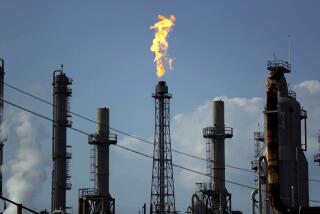Pursuing the polluters
- Share via
On March 29, 1967, Texaco struck oil deep in Sucimbios province in the northeast corner of Ecuador. The oil company christened the gusher Lago Agrio No. 1 (Spanish for “Sour Lake”) after Texaco’s first major oil strike in Texas in 1903. The name would prove to be ironic.
In partnership with Petroecuador, Ecuador’s national oil company, Texaco ramped up production at the site, which eventually grew to more than 220,000 barrels a day. From 1972 to 1992, the oil fields of Sucimbios produced more than 1.7 billion barrels of oil -- much of it exported to the U.S. Most of that oil around Lago Agrio No. 1 is gone. But what remains from the oil-boom years is almost incomprehensible pollution.
That environmental legacy includes as many as 16 million gallons of spilled crude -- 50% more than the Exxon Valdez dumped in Prince William Sound, Alaska, in 1989; hundreds of toxic waste pits, many containing the chemical-laden byproducts of drilling; and an estimated 18 billion gallons of waste, or “produced,” water, which some tests have shown to contain possibly cancer-causing polycyclic aromatic hydrocarbons at levels many times higher than those permitted in the U.S. All these pollutants were discharged in one of the most sensitive ecosystems in the world -- the Amazon rain forest.
In November 1993, lawyers representing dozens of indigenous residents who live in the Ecuadorean Amazon known as El Oriente filed a class-action suit in U.S. District Court in New York City. The suit, Aguinda vs. Texaco, alleged that the oil company discharged toxic petroleum waste into water used by residents for fishing, bathing and drinking, resulting in personal injury and widespread environmental damage. After 10 years, six motions to dismiss and two trips to the U.S. 2nd Circuit Court of Appeals in Manhattan, Chevron-Texaco -- the two oil giants merged in 2001 -- won. The judges ruled that a U.S. court was the wrong place to hear a suit involving a slender slice of land deep in the Ecuadorean jungle.
But the story wasn’t over. The appeals court had conditioned its dismissal of the suit on Chevron-Texaco’s willingness to go to trial in Ecuador and abide by whatever decision was rendered there. The company readily complied, possibly figuring that the plaintiffs would drop the matter and go away.
They didn’t, and the result could now produce the largest award in the history of environmental litigation.
There is nothing new, of course, about an environmental suit taking a decade to chug its way through the U.S. justice system. What’s groundbreaking about Aguinda vs. Texaco is what happened in Ecuador. The complexities of trying a major environmental case in a developing country generally prove to be too much for even the most committed plaintiffs. Similar suits have died on the vine after dismissal in U.S. courts.
But in May 2003, attorneys for the Chevron-Texaco plaintiffs flew to Ecuador, trekked to Lago Agrio -- the tiny jungle town at the center of the dispute -- and filed their suit. In doing so, they created the possibility of a judge in the developing world issuing a ruling that would be enforceable through U.S. courts.
The Ecuadorean court system is more inquisitorial than adversarial. Each side submits lists of witnesses, but it is the judge who decides whom to call and what to ask them. The first phase of the trial, known as the proof phase, started Oct. 21, 2003, and lasted six days -- the maximum allowed under Ecuadorean law. The local radio station broadcast the proceedings live over speakers strung across the unpaved streets below the courtroom.
The trial’s second “inspection” phase began in 2005, during which the judge visited dozens of the polluted sites named in the suit. Then, on April 1 of this year, Richard Cabrera, an independent environmental consultant appointed by the judge, submitted his report to the court. He suggested that a damage award against Chevron-Texaco be in the range of $8 billion to $16 billion. Although the judge has yet to rule, Cabrera’s report probably tipped the balance toward the plaintiffs because he is the only outside expert retained by the court.
Usually, an oil company facing such punishment would forfeit its assets in the country rather than pay the damages, and Chevron-Texaco’s remaining assets in Ecuador are meager. But the oil multinational doesn’t have that choice because it pledged to abide by the Ecuadorean judge’s decision, and plaintiffs see that as their sword of Damocles. (Among other arguments, the oil company contends that it is not a responsible party because it was a minority partner of Petroecuador, and that the Ecuadorean government released it in 1992 from any liability after it spent $40 million to clean up the sites.)
As painful as a multibillion-dollar judgment against Chevron-Texaco would be for the company and its shareholders, the legal signal it might send could be much more consequential. If the judge rules against the oil giant, plaintiffs in other developing countries that have suffered environmental degradation because of the business practices of multinational companies may follow the legal map laid out in Aguinda vs. Texaco. If so, developing nations could aggressively assert their sovereignty over multinational corporations, protecting their indigenous populations and ecosystems from the mining, drilling and timbering industries that have often written their own tickets.
More to Read
Sign up for Essential California
The most important California stories and recommendations in your inbox every morning.
You may occasionally receive promotional content from the Los Angeles Times.










